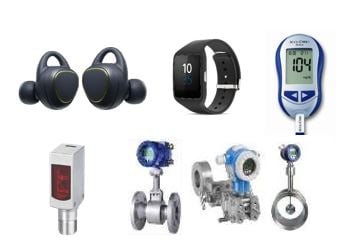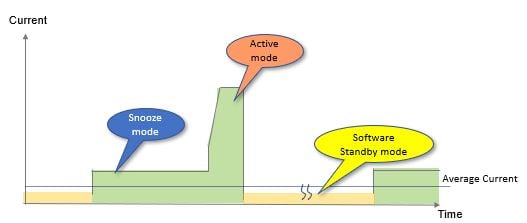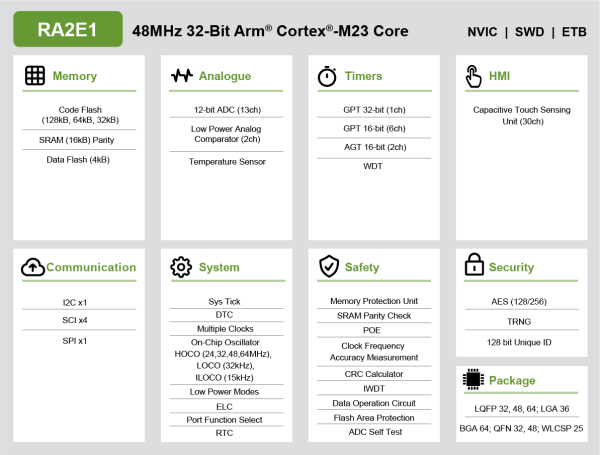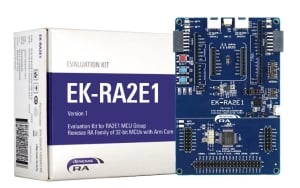Demand continues to rise dramatically for cost-sensitive and space-constrained applications that do more and perform better while consuming less power. Designers of consumer devices, industrial sensors and medical/healthcare markets are striving to produce very low power designs that are smaller and more portable.

Figure 1. Examples of space-constrained applications
In the context of this market trend, microcontrollers used in these applications are keenly required to be highly integrated, more compact and consume less power. The key enablers of such progress are a new generation of 32-bit microcontrollers that are much more power-efficient, such as the new Renesas RA RA2E1 group. The RA2E1 group is the RA Family’s new entry-level single-chip microcontroller based on the 48MHz Arm® Cortex®-M23 core. It offers up to 128KB code flash and 16KB SRAM memory and supports a wide operating voltage range of 1.6V to 5.5V. The RA2E1 MCUs are offered in a wide variety of package options such as LQFP, QFN, LGA, BGA, and WLCSP (Wafer Level Chip Scale Package). They deliver optimized combinations of superior performance, ultra-low power consumption, innovative peripherals, and small package options at price points that are ideal for high-volume wearables, portable consumer devices and industrial/IoT sensing nodes.
Figure 2. The RA2E1 Group block diagram
The RA2E1 group offers a 25-pin Wafer Level Chip Scale Package (WLCSP) that measures only 2.14mm x 2.27mm. It integrates high-accuracy analog functions, timers, capacitive touch function, multiple communication interfaces, as well as safety and security features into this tiny package to meet the requirements of space-constrained applications. This MCU group also enables system cost reduction with on-chip peripheral functions, including a high precision (1.0%) high-speed oscillator, temperature sensor, high current drive ports, and background operation data flash without having to increase printed circuit board (PCB) size to accommodate external components.

Figure 3. The RA2E1 25WLCSP (2.14mm x 2.27mm)
Additionally, the upgraded low power capability in the RA2E1 MCUs covers all on-chip peripherals, the Flash memory, and SRAM, allowing the smallest possible power consumption over the devices’ entire temperature and voltage range. In each of the low power operation modes, different MCU functions are stopped, saving various amounts of current. As a result, customers can extend the battery life and improve heat dissipation in small and enclosed housing. Here are the details describing the RA2E1 group’s low power operating modes:
- Sleep mode:
- The CPU is stopped with data retained. This reduces the CPU’s dynamic current consumption by 80%. It is a significant contributor to the RA2E1’s overall operating current.
- Software Standby mode:
- All the oscillators except the sub-clock and LOCO are stopped. Almost all the RA2E1’s modules – CPU, SRAM, Flash, DTC, and peripheral blocks – are stopped, with data retained. The Power-on-Reset (POR) circuit remains operational, and if necessary, the IWDT, RTC, LVD, and low power asynchronous timer modules can be operated. The RA2E1 typical software standby current is 250nA and RTC software standby current is 360nA. When waking up in the HOCO 48MHz, CPU operation begins after a typical 7.3µs delay.
- Snooze mode:
- The CPU is in the standby state while A/D conversion and serial communication are enabled, so the CPU is activated only when required. This mode is excellent for battery-powered systems as it greatly increases battery life.

Figure 4. The RA2E1 low power mode use case for battery-powered systems
The RA2E1 group is supported by a wide range of third-party development tools as well as Renesas' original development environments. The EK-RA2E1 evaluation kit enables users to seamlessly evaluate the features of the RA2E1 MCU Group and develop embedded systems applications using a best-in-class Flexible Software Package (FSP) and example projects. It will allow customers to jump-start development and will reduce time-to-market for new products.
Figure 5. Evaluation Kit (EK) for RA2E1 Group
To learn more about the Renesas RA2E1 MCU group, please visit renesas.com/ra2e1


